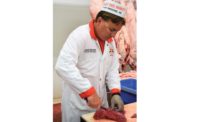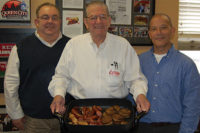
Anyone in the meat industry knows the country’s economic struggles have hit the foodservice sector particularly hard, with the higher-end restaurants faring the worst. Conventional wisdom would then say a regional, independent steak and seafood purveyor, catering to white-tablecloth restaurants, hotels and casino properties while competing with broadline distributors would be at a tremendous disadvantage. Halperns’, however, is anything but conventional.
Last year, Halperns’ increased its sales by more than $20 million, ending the year at approximately $155 million” not bad for a company that celebrated just its fifth anniversary this April. Things haven’t slowed down in 2010 either, as the company has often seen sales grow a million dollars a week over the previous year. The Atlanta-based company has been recognized by local and national publications as being one of the fastest-growing privately owned companies.
While the company may be relatively new, the founders have a long history of success in the meat industry. Howard Halpern, chairman, has been a part of the meat industry since 1966 and founded Buckhead Beef in 1983. CEO Kirk Halpern joined Buckhead Beef in 1989, and many of the people who are now part of Halperns’ management team came on board a couple years later.
Buckhead Beef was sold to broadline distributor SYSCO in 1999, and the management team stayed with the new owners and kept the business growing. In 2005, the founding family left the company and started Halperns’ soon after. Many key managers and other employees followed.
“Success comes from the quality of the people you have with you,” Howard says. He notes that the executive team” including Ray Hicks, president and chief operating officer, Ray Farmer, executive vice president, Jody Hicks, vice president, and Laura Barnard, chief financial officer” have been with him for well over a decade.
Also a part of the management team is Lynne Halpern, who has worked alongside Howard since the founding of the family business. Howard notes that managing accounts receivables, especially during rapid growth and challenging times, is a tricky business. Fortunately, Lynne and her team of industry veterans with decades of experience watch over the money.
“We were tremendously successful,” says Kirk, “and now we’ve brought that success to Halperns’.”
Along with increasing its sales and profitability in 2009, the company also took on projects that will ensure continued growth.
“The exciting thing is that we expanded into two additional cut shop facilities in Florida,” says Kirk. “At the same time, we continued to increase sales, and the expansion did not adversely affect our profitability.”
Culinary expertise
Halperns’ caters to white-tablecloth restaurants, hotels and country clubs, along with mid-range, family-style steakhouses. While the company has some multi-unit restaurants among its clientele, Hicks estimates that 60 percent of the customer base consists of owner-operated properties. Many of those owners work closely with the Halperns’ team in developing their cut steak specifications, even coming to Atlanta and visiting Halperns’ state-of-the-art facility.
Halperns’ takes a partnership approach with its customers to develop the specifications that will exceed the diner’s expectations and is cost affective for the operator. Once the specs are agreed upon the operator is able to call Halperns’ one day with an order and get it delivered the next.
“We deliver next day through the entire Southeast, and we deliver multiple times through the week to the Midwest and Northeast, and as far west as Dallas, Texas,” he explains. Along with providing top-quality steaks and chops to its customers, the company also offers poultry, game, lamb, veal and fresh and frozen seafood.
Farmer, himself a Certified Executive Chef and a past winner at the Culinary Olympics in Frankfurt, Germany, notes that the company’s salesforce puts considerable emphasis on consulting and problem-solving, along with selling product.
“We’re interested in helping them grow their business and be successful, because we realize that, as they are successful, we will continue to grow,” he explains. “We want to partner with them, and we’re not interested in the one-time transaction and whatever [short-term] benefits that might bring our way.”
Like Farmer, many on the sales team have professional culinary backgrounds. While Halperns’ customers have taken advantage of that expertise in the past, they relied on it more than ever this past year.
“As times got tough, customers were looking for solutions,” points out Kirk Halpern. “Because we are meat and seafood people, and our sales reps are predominantly chefs and culinarians, we were really able to use our expertise to give them some value alternatives, so as to allow them the opportunity to give to their customers great steaks, great meat products, at a value.”
That expertise helped the company gain new customers as well. In the past, a customer may have been comfortable with an existing meat supplier and wasn’t looking for a change. With the current state of the foodservice industry, everyone is looking for solutions and is more willing to make changes in suppliers.
Ideas that provide value have been particularly popular, whether it is a slight reduction in portion size or the utilization of a different type of cut.
“Last year, the pounds were up strong,” Hicks says. “That was indicative of our ability to shift gears and get the more value cuts out there, and help these guys through the tough times.”
He says the production room management team members are masters at creating new items and will work directly with customers, senior management and the salesforce to get them what they want.
The company’s culinary expertise gives customers a broad spectrum of possible options for their menus. Kirk Halpern notes that 10 years ago, there was probably one or two style of short ribs that were sold.
“We are probably processing about 20 types of short ribs, from an osso bucco short rib to a French short rib to a single-bone short rib,” he says. “We’re pretty good at identifying what [customers’] specifications are and giving options that work, and then they make the decision.”
Halperns’ has also developed strong relationships with its upstream suppliers in order to provide a wealth of options for the downstream customers. In terms of pork products, Kirk notes, there is a commodity line of pork, a Kurobuta line of pork, an all-natural pork line from Niman Ranch and locally grown pork from a hog farmer in Alabama, just to name a few varieties.
The company also communicates frequently with its meat suppliers to help market underutilized items. A veal breast is an excellent cut of meat, but it is very labor intensive for the chef and thus not as popular. Halperns’ was able to work with one of its veal suppliers to obtain and successfully market a veal breast that had all the bones, fat and sinew removed that didn’t require as much work.
Red meat is the bulk of the company’s sales, but it is just one part of the total portfolio. Halperns’ also offers poultry and wild game, and it has a room in its Atlanta facility devoted to fish cutting. Along with the ability to provide a full range of protein products to its customers, it has multiple entry points into a customer’s business. Kirk notes that there are many cases where the company started supplying shrimp or venison to a restaurant and expanded from there.
As an independent company, Halperns’ is able to reach out to more channels in order to get unique products. Their merchandising team works directly with small artisan farmers and fishermen. That type of freedom has been liberating for the Halperns’ team.
“We have the ability to react quickly and make decisions really fast,” Barnard, the CFO, says, “and we have that support all the way through the chairman to make strategic decisions fast, where in other companies it would take longer.”
Goin’ south
When Halperns’ first began operations on April 29, 2005, it was working out of a warehouse. It eventually added a space in a USDA-inspected facility where Farmer and a few others cut steaks on two tables. At one point, the company was operating out of a cooler, two freezers, a production facility and an office, all in different locations around Atlanta.
“We literally had three drivers on our payroll who did nothing except move product between buildings,” Hicks recalls.
In spite of the disadvantages, the company grew quickly. It sold $11,827 in its first week, and topped a million dollars a week before it was a year old. Kirk Halpern notes that the company started with more than 100 years of business experience and was able to capitalize on the relationships the management had built.
“At the same time,” he adds, “we needed to demonstrate value to the customer. Our relationship allowed us to get in front of the customer, but we had to bring them something better. Just to change because they knew us wasn’t good enough” and it shouldn’t be good enough.”
“We also had to prove that we could execute, that we could do all the block-and-tackle things like distribution, getting the trucks out on time,” Barnard adds.
Halperns’ moved to its current 110,000-square-foot, state-of-the-art facility in 2006, with much of its team working through the night to move the equipment, raw materials and offices without interrupting business.
“Now, we have a facility where we can scale the company three, four times larger than we are today,” Barnard says. The building is also designed with impeccable food sanitation, food safety and employee comfort in mind. A unique cooling system eliminates condensation. Boxes are constructed outside the facility and gravity-fed to the cut shop. An entry-way sanitation system sprays foam onto the floor, so all footwear and cart wheels are sanitized. The meat is also sprayed with an antimicrobial rinse.
With the new facility, the management wasn’t looking to expand to a new location, at least not so quickly. It did partner with two distribution facilities in Central and South Florida to act as a cross-dock facility. Last year, an opportunity arose to expand those operations.
“As a result of some new business that we took on, part of our commitment to this new business was that we would have facilities there to take care of same-day service,” Hicks says. “Even though Atlanta remains the primary processing and distribution center, we had to make that commitment.”
Halperns’ took over both facilities and kept on the employees that could be an integral part of the team. One of the buildings was scheduled to close, and the employees had previously been told that they would be out of work in less than 30 days. Halperns’ management identified the need one day, opened the first cut shop 60 days later and the second one 21 days after that.
“It was a fairly sizable investment on the front end to obtain this business, but it’s worked out very well for us,” Hicks says. “It’s allowed us to do some things today that we never imagined being able to do as part of our service to those customers in the area.”
The Florida business is an area that has strong growth opportunity, Barnard says.
“We can double to triple our business in the next three years in the Florida market,” she says. On top of that, the company sees plenty of opportunity to expand its fresh and frozen seafood lines within its current customer base. All in all, she says, “we clearly want to double business within the next few years. We will one day have sales in excess of $500 million.”
Kirk Halpern says that the company will continue to grow geographically. As its restaurant and casino customers expand their reach, Halperns’ has a good opportunity to grow with them. It’s already happening with its current customers.
“I think it’s reasonable to think that as we continue to do a very good job for customers within our current scope, many of those customers are going to want to take us beyond it.”
Expanding into the Northeast to service the casino business is likely to occur, he adds.
The company also has a growing export business in the Caribbean, and Halperns’ has been able to offer its next-day service to locales such as Puerto Rico. As more places open to U.S. exports, Halperns’ can take advantage of the ports and airports in Atlanta and South Florida and grow into far-off destinations including Asia.
Having spent more than 40 years in the meat industry, Howard Halpern was a part of the growth of steak usage in the restaurant industry. He says he remained in the industry after leaving his former business because he saw an opportunity. He notes that in a short period of time, broadline distributors bought about 35 of the top independent meat companies in the country, including his own.
“What [then] happened was, for the most part, sooner or later, the founder left. The son or daughter or son-in-law left,” he explains. “The company moved away from being attached to its customer base and its employee base, and became more systematized on a corporate level. In much too many cases, the size of the company began to diminish and the growth disappeared.”
Furthermore, the distributor-owned companies began to deliver product to the distributor rather than the customer, causing them to further lose touch with their customers. Operating costs rose as the corporate structure set in.
“At the end of the day, what we saw was that the top-quality competitors of a decade prior were no longer as effective as they once were,” Howard explains. “As entrepreneurs, we saw that as a business opportunity, so we said, ‘Let’s go back and do it right.’”
He notes that the success of Halperns’ has been both personally and financially rewarding.
“The bottom line, in all my years of business, we are performing today at the highest level of quality, service, and customer satisfaction than I was ever involved with in my entire career,” he says. “We just get up each day and do a better job than yesterday, and we encourage our competitors to do the same.”




Report Abusive Comment